Doberman Pinschers, known for their intelligence and loyalty, are a breed often chosen for their protective instincts.
However, their compatibility with cats concerns potential pet owners with feline companions or considering adding one to their household.
Understanding the nature of Dobermans and their relationship with cats is essential for creating a harmonious multi-pet home. In this article, we will explore the relationship between these two and answer the question: Are Dobermans good with cats?
Are Dobermans Good With Cats?
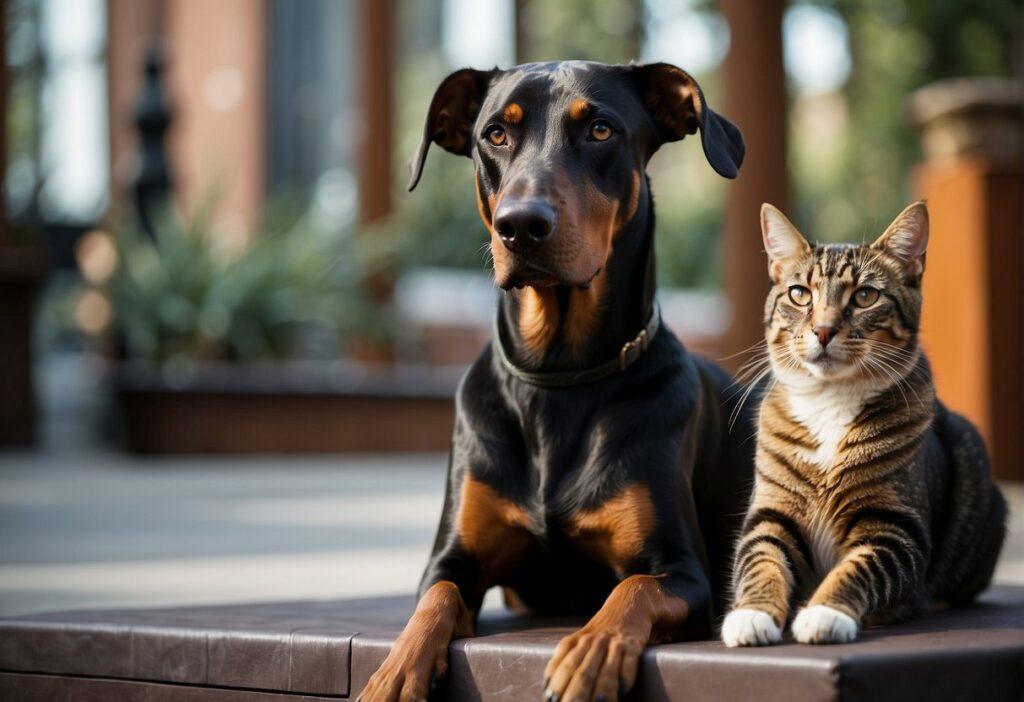
The cat-friendliness of a Doberman can largely depend on the individual dog’s personality, training, and socialization.
Dobermans are not inherently aggressive towards cats, but their high prey drive can lead to chasing behaviors that can stress or endanger a cat if not appropriately managed.
Early socialization and training can play a critical role in helping a Doberman learn to coexist peacefully with cats.
When introducing Dobermans to cats, it’s important to supervise their interactions closely, especially during the early stages.
With patience and the proper introductions, many Dobermans can learn to accept and even form bonds with their feline counterparts.
This integration process requires consistent guidance from the owner to ensure safety and positive experiences for both the dog and the cat.
Doberman Pinscher Breed Overview

The Doberman Pinscher is a breed well-regarded for its loyalty and impressive stature, which makes it an effective guard dog.
Its history is rooted in Germany, and this dog is known for its muscular physique and the potential for distinct health conditions.
History and Origin
Originating in Germany in the late 19th century, the Doberman Pinscher was created by Karl Friedrich Louis Dobermann, a tax collector who sought a medium-sized guard dog to accompany him.
It is believed that German Pinschers and other breeds like Rottweilers and Weimaraners were used to develop the Doberman’s distinct features.
They were primarily used as guard dogs and were later trained for police and military roles due to their intelligence and loyalty.
Temperament
Dobermans are known for their loyalty and can protect their family, often standing as vigilant guard dogs.
They possess a high prey drive, requiring careful attention when interacting with small animals.
However, with proper socialization, they can learn to coexist with pets like cats. Training early is crucial to ensure they are well-behaved and amiable.
Physiology
Physiologically, Dobermans are solid and agile dogs characterized by a sleek coat and muscular build. They typically have a black coat with rust-colored markings, although variations do exist.
They are generally healthy, but like many purebred dogs, they can be prone to certain health conditions, including cardiomyopathy, hip dysplasia, and von Willebrand’s disease, which potential owners should be aware of.
Regular exercise and proper care are essential to maintain their well-being.
Understanding Doberman Behavior
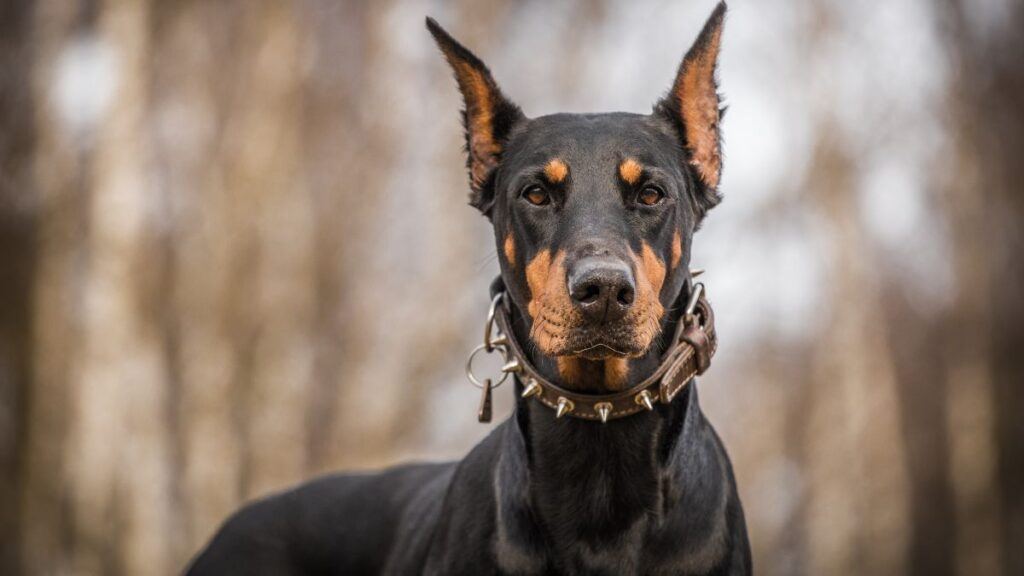
Dobermans are known for their strong protective instincts and high-energy nature. Proper training and socialization are crucial in managing their prey drive and ensuring good behavior.
Prey Drive and Instincts
Dobermans possess a significant prey drive that can manifest as chasing behaviors. This characteristic stems from their historical use as guard dogs, where quick reactions to moving stimuli were desirable. To mitigate problematic behavior:
- Training: Implement consistent training sessions emphasizing positive reinforcement to curb chase instincts.
- Mental Stimulation: Provide adequate mental stimulation to keep their instincts positively engaged.
Socialization and Training
Socialization from a young age can help a Doberman learn to behave appropriately around other animals, such as cats.
- Early Introduction: Introduce cats during the Doberman’s puppy stage to promote better acceptance.
- Consistent Training: Reinforce training with regular practice and positive reinforcement techniques.
Health and Exercise
Dobermans are high-energy dogs requiring regular exercise for their physical and mental well-being.
- Physical Activity: Ensure they receive enough exercise to mitigate excess energy that can contribute to chasing behavior. Exercise Type Duration Frequency Brisk Walking 30-60 minutes Daily Running/Agility Sports 20-30 minutes 2-3 times per week
- Routine: Establish a routine that includes regular health check-ups to maintain their overall welfare.
Related: Are Cat and Dog Years the Same?
Dobermans and Their Relationship With Cats
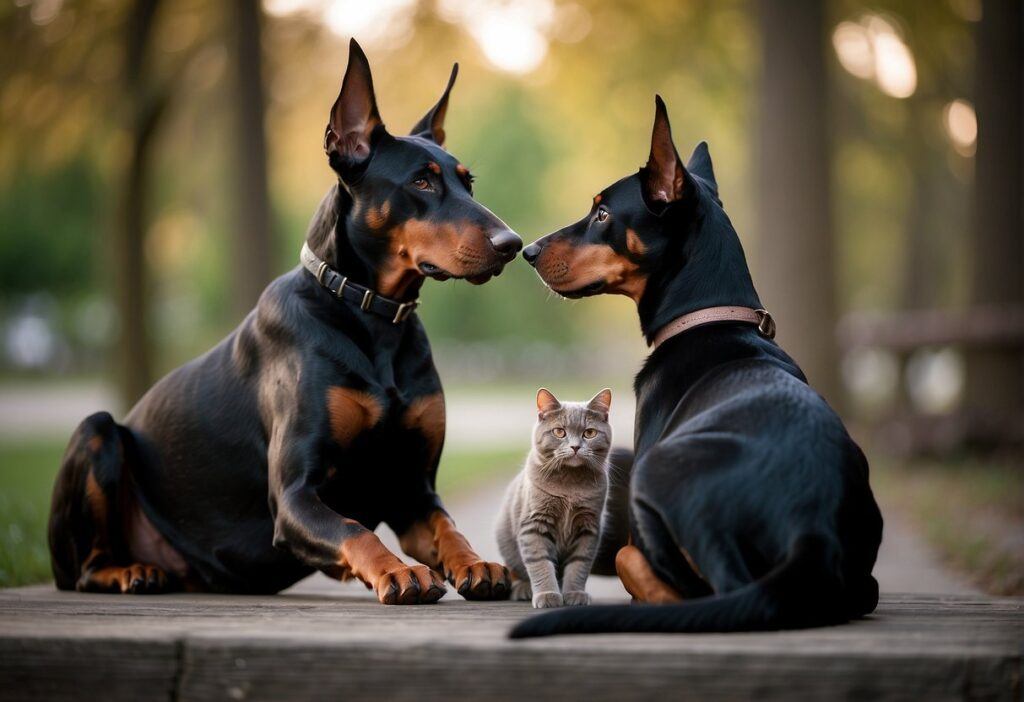
Dobermans can develop harmonious relationships with cats, especially with proper introductions and an understanding of their space needs.
Initial Introductions
Initial introductions should be carefully managed to foster a positive association between a Doberman and a cat.
Keeping the Doberman leashed and allowing the cat to have her own space can prevent stress and potential aggression.
Introductions should be done gradually, ensuring that both animals feel safe and comfortable.
- Step 1: Allow them to smell each other’s scent before meeting.
- Step 2: Keep the Doberman on a leash during the first face-to-face interaction.
- Step 3: Supervise closely and separate them if signs of distress occur.
Building Bonds
Repeated positive interactions are crucial for becoming best friends for a Doberman and a cat. Treats and praise can be used to reinforce good behavior from both the Doberman and the cat.
There must be consistent, calm, and patient guidance for building a happy relationship.
- Positive Reinforcement: Reward calm behavior around each other.
- Shared Activities: Both pets can enjoy activities such as playtime in a controlled environment.
Maintaining a Peaceful Coexistence
Long-term peace between an adult Doberman or a Doberman puppy and a cat requires respect for their individual needs for their own space and downtime. Each pet should have a safe area they can retreat to. Consistent rules and a stable environment can help sustain a peaceful coexistence.
- Separate Spaces: Provide separate resting areas and feeding stations.
- Consistent Routine: Regularly schedule for feeding, play, and quiet time to maintain stability.
Training Practices for Harmonious Living
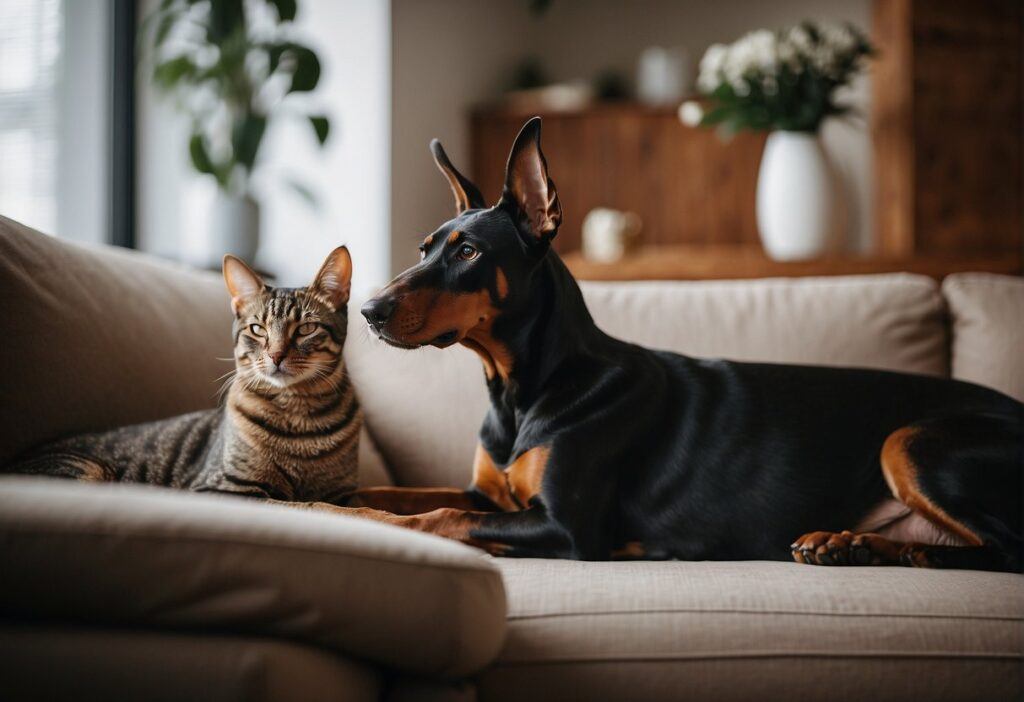
Effective training practices are crucial for fostering a peaceful relationship between Dobermans and cats. Specifics such as early socialization, ongoing training, and addressing aggression are pivotal in ensuring harmonious cohabitation.
Early Socialization
To foster a friendly relationship between Dobermans and cats, it is essential to start socialization early.
Doberman puppies should be introduced to cats in a controlled, calm environment to ensure positive interactions.
Exhibiting patience during their interactions allows the Doberman to become accustomed to the cat’s presence, reducing the likelihood of aggressive behavior later on.
- Key Steps for Early Socialization:
- Introduce the Doberman to the cat gradually.
- Monitor their interactions closely.
- Keep initial meetings short and incrementally increase their length.
Ongoing Training
Continual training is vital for maintaining a Doberman’s good behavior around cats. Regular exercise partnered with obedience training helps mitigate excess energy and reinforces positive behavior.
Incorporating consistent commands and rewards can establish a clear communication pathway between the owner and the Doberman, allowing for swifter intervention if negative interactions occur.
- Components of Ongoing Training:
- Consistency: Utilize regular commands and routines.
- Exercise: Engage the Doberman in daily activities to expend energy.
- Rewards: Positive reinforcement enhances learning.
Addressing Aggression
Understanding and managing signs of aggression from a Doberman towards a cat is essential.
Owners should be proactive in recognizing signs such as growling, stiff posture, or focused staring and should intervene early to prevent escalation.
Providing proper care, setting boundaries, and possibly consulting a professional trainer can enable the prevention and correction of aggressive tendencies.
- Strategies for Addressing Aggression:
- Observation: Be vigilant for cues of discomfort or aggression.
- Intervention: Separate the animals at the earliest sign of aggression.
- Professional Help: Seek the assistance of a trainer if aggression persists.
Integrating a Doberman into a Cat-Inclusive Household
Introducing a Doberman Pinscher dog into a household with cats can be a good idea, provided the dog owners are prepared and informed.
The Doberman, a dog breed that originated in the late 1800s, is known for its energy, intelligence, and loyalty.
Understanding the breed’s characteristics and needs is essential for families considering adding a Doberman to their mix of furry family members, especially in a multi-pet household.
Preparation is Key
First-time Doberman owners should note that these dogs, while capable of becoming great friends with cats, possess much energy that needs to be channeled properly.
Before bringing a Doberman home, preparing the environment to ensure a safe and gradual introduction to feline housemates is crucial.
- Using a Baby Gate: A baby gate is an effective tool to create controlled meeting spaces and ensure both pets have their escape route if they feel overwhelmed. This setup allows for gradual and supervised interaction, which is essential for building trust between the dog and cat.
- Creating Safe Spaces: Ensuring the Doberman and the cat have safe spaces is vital. Cats often need high perches or separate rooms to retreat to, while Dobermans appreciate a designated rest area where they can relax away from the high-energy play.
Understanding the Doberman
The Doberman Pinscher Club of America provides valuable resources for understanding this breed’s temperament and needs.
Dobermans are energetic and require regular exercise to manage their energy levels. Without adequate physical and mental stimulation, a Doberman may direct its energy in undesirable ways, including overly boisterous play with cats.
Health and Longevity
Prospective dog owners should also be aware of health issues specific to the Doberman breed.
Regular veterinary check-ups and awareness of breed-specific health concerns are important for the long-term well-being of the Doberman, ultimately affecting its interaction with other family pets.
A healthy Doberman is more likely to engage positively with feline companions.
Building Lasting Friendships
Dobermans and cats can become great friends with patience, proper training, and a structured introduction plan.
The key is to respect each pet’s personality and needs, providing a balanced environment where both can thrive.
Remember, the successful integration of a Doberman into a cat-inclusive household depends mainly on the commitment and consistency of the dog owners.
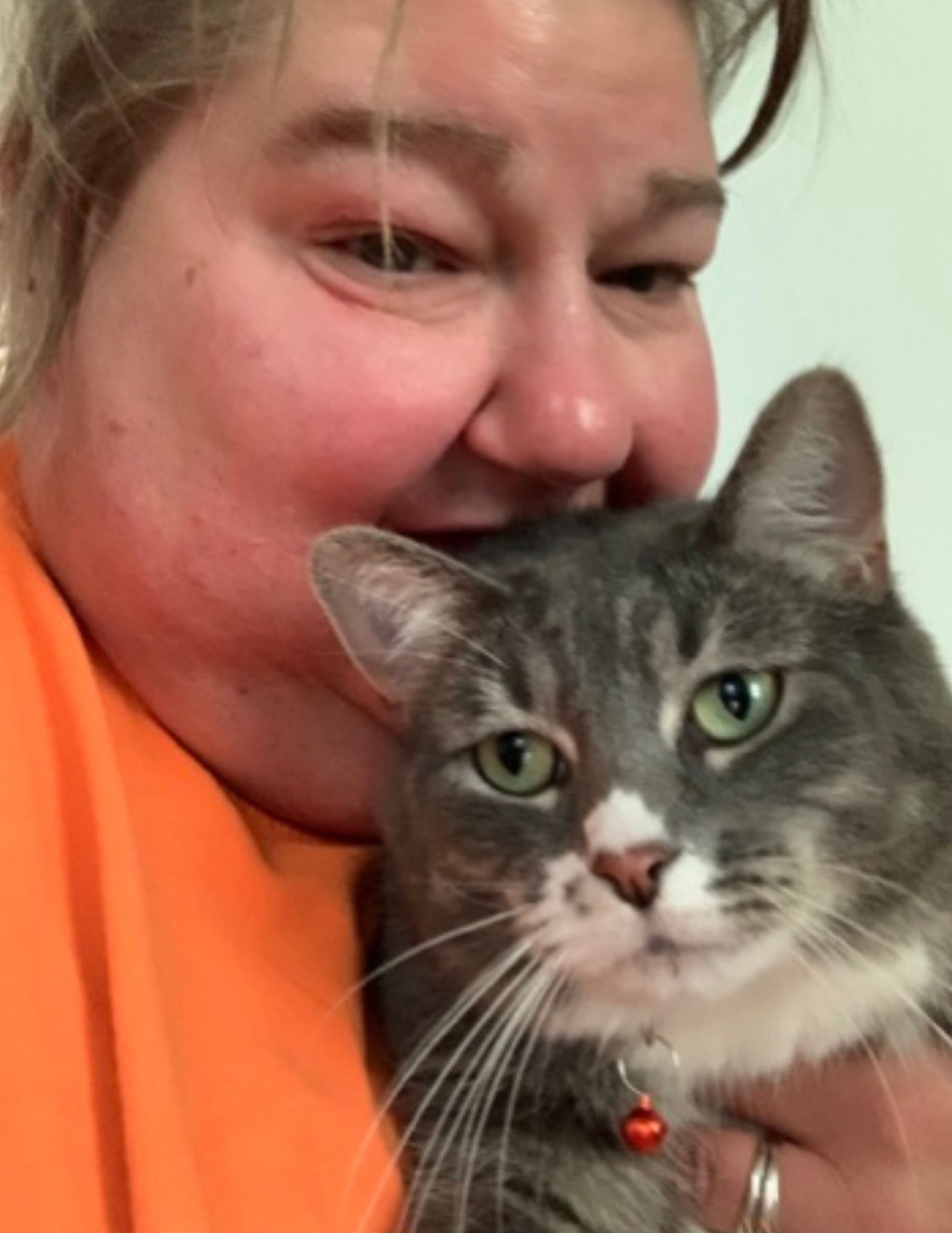
Meet Ann Haasnoot, the passionate founder of CatFurLife.com. A lifelong cat lover from Wisconsin, Ann combines her extensive feline behavior and care knowledge with her love for writing. On her website, she shares invaluable insights about cat breeds, care tips, and her experiences with her beloved furbaby, aiming to deepen the bond between cats and their human companions.

